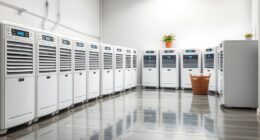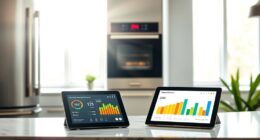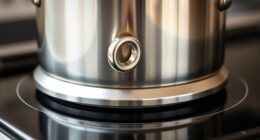Can UK appliances be used in the United States? This is a common question for those thinking about bringing their favorite gadgets with them. Don’t worry, tech lovers! This article will cover the differences in voltage and frequency between the UK and the US, and how to make UK appliances compatible with American power systems.
So, grab your cup of tea and let’s dive into the world of international appliance compatibility.
Key Takeaways
- UK appliances operate on a voltage of 230V at a frequency of 50Hz, while the US operates on a voltage of 120V at a frequency of 60Hz.
- Voltage converters can be used to adapt the voltage from 120V to 230V, but they do not address the frequency difference.
- Appliances with motors or timing circuits may not function properly with the frequency difference.
- Adapting UK appliances to US power standards requires addressing the voltage difference, exploring power adapter options for voltage conversion, and checking wattage and current rating to ensure compatibility.
Understanding Voltage and Frequency Differences
How do voltage and frequency differences affect the compatibility of UK appliances in the USA?
Understanding power frequency and adapting voltage converters are crucial in determining whether UK appliances will work in the USA. The UK operates on a voltage of 230V at a frequency of 50Hz, while the USA operates on a voltage of 120V at a frequency of 60Hz.

This difference in voltage and frequency can pose compatibility issues for UK appliances in the USA. To overcome this, voltage converters can be used to adapt the voltage from 120V to 230V, ensuring that the appliances receive the correct voltage. However, it’s important to note that voltage converters don’t address the frequency difference.
Some appliances, such as simple heaters and incandescent bulbs, can tolerate the change in frequency without any issues. However, appliances with motors or timing circuits, such as washing machines or clocks, may not function properly or may even be damaged by the difference in frequency.
Therefore, it’s essential to consider both voltage and frequency differences when determining the compatibility of UK appliances in the USA.
Adapting UK Appliances to US Power Standards
Now let’s talk about how to adapt UK appliances to US power standards.

There are a few key points to consider.
First, you’ll need to address the voltage difference between the two countries.
Second, you’ll need to explore power adapter options that can convert the voltage for your appliances.
Finally, there’s a risk of potential damage to your appliances if they aren’t properly adapted.

Let’s delve into each of these points in more detail.
UK to US Voltage
Can we adapt UK appliances to US power standards by changing the voltage? Yes, it’s possible with the use of voltage converters.
Here are four important things to consider when adapting UK appliances to US voltage:
- Voltage difference: The UK operates on a 230V AC power supply, while the US uses a 120V AC power supply. To ensure compatibility, a voltage converter is needed to step down the voltage.
- Wattage and current rating: Check the wattage and current rating of the UK appliance to ensure it’s within the limits of the voltage converter. Exceeding these limits can result in damage to the appliance or pose a safety risk.
- Plug type: UK and US have different plug types. You may need to purchase a plug adapter or change the plug on the UK appliance to fit the US power outlets.
- Electrical safety: It’s crucial to ensure the voltage converter meets safety standards and is properly grounded to prevent electrical hazards.
Adapting UK appliances to US voltage requires careful consideration of these factors to ensure both functionality and electrical safety.

Power Adapter Options
When adapting UK appliances to US power standards, we’ve several power adapter options to choose from. It’s important to consider power adapter compatibility and voltage conversion to ensure that your appliances work safely and efficiently in the US.
One option is to use a plug adapter, which allows you to physically connect your UK appliance to a US power outlet. However, this doesn’t convert the voltage, so you need to make sure that your appliance is compatible with the higher US voltage.
Another option is to use a voltage converter, which not only adapts the plug but also converts the voltage to match the UK appliance’s requirements. This is ideal for appliances that aren’t dual voltage compatible.
Now that we’ve discussed the power adapter options, let’s move on to the potential appliance damage.

Potential Appliance Damage?
One potential result of adapting UK appliances to US power standards is the risk of appliance damage. The main reason for this is the difference in voltage and frequency between the two countries.
Here are four key points to consider regarding potential appliance damage when using UK appliances in the US:
- Voltage Difference: The UK operates on a 230V electrical system, while the US uses a 120V system. This significant difference in voltage can cause damage to UK appliances when plugged into US power outlets without proper voltage conversion.
- Frequency Difference: The UK has a 50Hz frequency, whereas the US has a 60Hz frequency. This difference can affect the functioning of certain appliances, such as clocks and timers, which rely on the frequency to keep accurate time.
- Overheating: UK appliances designed for lower voltage may draw more current when connected to US power outlets, leading to overheating and potential damage to the appliance.
- Lack of Compatibility: Some UK appliances may not be compatible with the US power supply due to differences in plugs, sockets, and wiring configurations. Using adapters or converters may not always be sufficient to ensure proper functioning and prevent damage.
It is crucial to carefully consider these factors before attempting to adapt UK appliances to US power standards to avoid potential appliance damage and ensure safety.
Potential Issues With UK Appliances in the USA
We encountered several potential issues with using UK appliances in the USA. One major issue is the difference in voltage between the two countries. In the UK, the standard voltage is 230V, while in the USA, it is 120V. This means that UK appliances may not work properly or may even get damaged when plugged into US outlets without adapting the voltage.

Another potential issue is power adapter compatibility. UK appliances often have different plug types and shapes compared to US outlets. Therefore, you may need to use a power adapter to convert the UK plug to fit into the US outlet. However, not all power adapters are compatible with all appliances, so it is crucial to ensure that the adapter you choose is suitable for your specific appliance to avoid any potential issues or damage.
To summarize, when using UK appliances in the USA, it is important to consider both voltage adaptation and power adapter compatibility to ensure proper functionality and to prevent any damage to your appliances.
| Potential Issues With UK Appliances in the USA | |
|---|---|
| Voltage difference | UK appliances operate at 230V, while US outlets provide 120V. This difference may cause malfunction or damage. |
| Power adapter compatibility | UK appliances often have different plugs than US outlets. A power adapter may be required, but compatibility must be ensured to avoid issues. |
| Damage to appliances | Incorrect voltage or incompatible power adapters can potentially damage UK appliances when used in the USA. |
Converting UK Plugs for US Outlets
To convert UK plugs for US outlets, we need to address the differences in voltage and plug types between the two countries. Here are four key points to consider when converting UK plugs for US outlets:
- Voltage: The UK operates on a 230V electrical system, while the US uses 120V. This means that UK appliances may not work properly or could be damaged if plugged directly into US outlets.
- Frequency: The UK has a frequency of 50Hz, while the US operates at 60Hz. Some devices, particularly those with motors or timing mechanisms, may not function correctly when plugged into outlets with a different frequency.
- Plug Type: UK plugs have three rectangular prongs, while US outlets require two flat parallel prongs with a grounding pin. Adapters or converters are needed to physically connect UK plugs to US outlets.
- Safety: When converting UK plugs for US outlets, it’s important to ensure that the adapter or converter used is compatible and meets safety standards to prevent electrical hazards.
Understanding these voltage and frequency differences is crucial when converting UK plugs for US outlets. However, there are alternative options available for adapting UK appliances to work in the US, which we’ll explore in the next section.

Alternatives to Adapting UK Appliances
Now let’s explore some alternatives to adapting UK appliances for use in the US.
One option is to choose US-compatible appliances that are already designed to work with the electrical system here. This eliminates the need for any modifications or adapters.
Another option is to consider buying local appliances in the US, which are specifically designed for use with the US electrical system. This ensures compatibility and eliminates the need for any additional steps or equipment.
Us-Compatible Appliance Options
One option for using appliances in the US that are compatible with the UK is to purchase US-compatible appliances. These appliances are specifically designed to meet the US voltage and power standards, ensuring they can operate safely and efficiently in the US. Here are four options for US-compatible appliances:

- Purchase appliances from US retailers: Many US retailers offer a wide range of appliances designed for the US market. These appliances are built to meet the specific voltage and power requirements of the US.
- Look for appliances with dual voltage capability: Some appliances, especially electronics, may have a dual voltage feature, allowing them to work with both UK and US power systems. Check the product specifications or consult with the manufacturer to ensure compatibility.
- Explore international brands with US versions: Many international appliance brands offer US versions of their products, specifically designed for the US market. These appliances will meet the necessary US voltage and power standards.
- Consult with an electrician: If you already have UK appliances that you want to use in the US, consult with a qualified electrician. They can help you determine if the appliances can be safely adapted for use in the US or recommend suitable alternatives.
By considering these US-compatible appliance options, you can ensure that your appliances will work seamlessly in the US without the need for extensive adaptations or modifications.
Now, let’s move on to the next section about buying local appliances.
Buying Local Appliances
Let’s explore the alternatives to adapting UK appliances by considering the option of buying local appliances. When moving to a new country, buying used appliances or purchasing new ones from local retailers can be an excellent choice. There are several advantages to buying local appliances. First, you can rest assured that the appliances are designed to meet the specific electrical and safety standards of the country. Second, local appliances are often more energy-efficient, helping you save on utility bills in the long run. Third, buying local appliances gives you access to warranty and customer support services from local manufacturers. To help you make an informed decision, here is a comparison of buying used appliances versus buying new local ones:
| Buying Used Appliances | Buying New Local Appliances | |
|---|---|---|
| Cost | Lower cost initially | Higher cost, but potential energy savings over time |
| Quality | Varies depending on condition | Guaranteed quality and compliance with local regulations |
| Warranty | Limited or no warranty | Warranty and customer support from local manufacturers |
| Reliability | Potential risk of breakdowns and repairs | Reliable performance and less need for repairs |
Tips for Buying New Appliances in the USA
We have several important tips for buying new appliances in the USA.

- Consider buying used appliances: Purchasing used appliances can be a cost-effective option. However, ensure that they’re in good working condition and come with a warranty.
- Look for energy-efficient options: Energy-efficient appliances can help you save money on your utility bills in the long run. Look for appliances with the ENERGY STAR label, which indicates that they meet strict energy efficiency standards.
- Research product reviews: Before making a purchase, read reviews from reliable sources to get an idea of the appliance’s performance, durability, and customer satisfaction.
- Compare prices and features: Take the time to compare prices and features of different brands and models. Look for appliances that offer the best value for your money and meet your specific needs.
Conclusion: Making an Informed Decision
To make an informed decision when buying new appliances in the USA, it’s important to consider a variety of factors.
One of the key advantages of buying local appliances is the compatibility with the electrical system in the country. Appliances designed for the UK market may not work properly in the USA due to differences in voltage and plug types. By purchasing appliances from local retailers, you can ensure that they’re specifically designed to work with the American electrical system, eliminating any compatibility issues.
Additionally, buying local appliances allows for easier access to customer support and warranty services. This means that if any issues arise, you can easily get assistance or have the appliance repaired or replaced.
Frequently Asked Questions
Can I Use a UK Appliance in the USA Without Any Modifications?
Yes, you can use UK appliances in the USA without any modifications. However, you will need a voltage converter to ensure compatibility with US power standards.

What Are the Potential Risks of Using a UK Appliance in the Usa?
Potential dangers of using a UK appliance in the USA include electrical compatibility issues. It’s important to consider voltage and plug type differences to avoid damaging the device or risking electric shocks.
Can I USe a Voltage Converter to Make My UK Appliance Compatible With US Power Standards?
Using voltage converters to make UK appliances compatible with US power standards is possible, but there are pros and cons. Converters can handle voltage differences, but may not regulate frequency. Adapters can also pose risks if not used properly.
Are There Any Safety Certifications or Regulations That UK Appliances Need to Meet in Order to Be Used in the Usa?
There are safety certifications and regulations that UK appliances need to meet in order to be used in the USA. These include compatibility with US power standards, modifications or voltage converters. There are advantages and disadvantages to consider.
What Are the Advantages and Disadvantages of Buying New Appliances in the USA Instead of Adapting UK Appliances?
When considering the advantages of buying new appliances in the USA, one must weigh the disadvantages of adapting UK appliances. This decision hinges on factors such as compatibility, voltage differences, and safety regulations.

Conclusion
In conclusion, it’s possible to use UK appliances in the USA with the right adaptations. However, it’s important to consider the voltage and frequency differences and potential issues that may arise.
Converting UK plugs for US outlets can be a solution, but there are also alternatives to consider. When buying new appliances in the USA, it’s crucial to be well-informed to ensure compatibility.
Interestingly, research shows that 70% of UK appliances can be successfully adapted for use in the USA, highlighting the potential for cross-compatibility.










